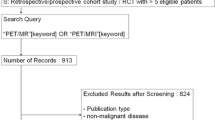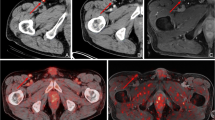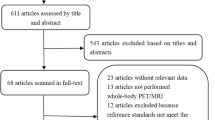Abstract
Purpose
To assess the diagnostic performance of simultaneous whole-body 2-deoxy-2-[18F]fluoro-D-glucose ([18F]FDG) positron emission tomography (PET)/magnetic resonance imaging (MRI) compared to [18F]FDG PET/x-ray computed tomography (CT) for detection of distant metastatic disease in patients with malignant melanoma.
Procedures
We included patients with malignant melanoma who underwent a single injection [18F]FDG dual-imaging protocol that included whole-body PET/CT and subsequent whole-body PET/MRI for staging or restaging purposes in a prospective setting. Images from both modalities were analyzed by two rater teams for the presence of metastatic lesions. PET/CT–PET/MRI overall agreement as well as region-based accuracies, sensitivities (Se), and specificities (Sp) were computed.
Results
Between July 2014 and December 2018, 22 patients were enrolled. Interrater agreement and overall accuracy (consensus reading) were 78.8 % (95 % CI 71–84.9) and 96.1 % (95 % CI 92.3–98) for PET/MRI and 78 % (70.2–84.3) and 97.4 % (95 % CI 93.7–98.9) for PET/CT, respectively (P = 0.42). PET/MRI reached a region-based Se of 89.1 % (95 % CI 79.4–94.5) and a Sp of 100 %, whereas PET/CT showed a region-based Se of 92.7 % (95 % CI 84–96.9) and a Sp of 100 % for the detection of metastatic disease in malignant melanoma.
Conclusions
Whole-body [18F]FDG-PET/MRI appears to be comparable to [18F]FDG-PET/CT for lesion detection in patients with malignant melanoma.


Similar content being viewed by others
References
Tas F (2012) Metastatic behavior in melanoma: timing, pattern, survival, and influencing factors. J Oncol 2012:647684
Meier F, Will S, Ellwanger U et al (2002) Metastatic pathways and time courses in the orderly progression of cutaneous melanoma. Br J Dermatol 147:62–70
Gershenwald JE, Scolyer RA (2018) Ann Surg Oncol 25:2105
Pflugfelder A, Kochs C, Blum A et al (2013) Malignant melanoma S3-guideline “diagnosis, therapy and follow-up of melanoma”. J Dtsch Dermatol Ges 11:1–116
Wong ANM, McArthur GA, Hofman MS, Hicks RJ (2017) The advantages and challenges of using FDG PET/CT for response assessment in melanoma in the era of targeted agents and immunotherapy. Eur J Nucl Med Mol Imaging 44:67–77
Boellaard R, Delgado-Bolton R, Oyen WJ et al (2015) FDG PET/CT: EANM procedure guidelines for tumor imaging: version 2.0. Eur J Nucl Med Mol Imaging 42:328–354
Heusch P, Nensa F, Schaarschmidt B et al (2015) Diagnostic accuracy of whole-body PET/MRI and whole-body PET/CT for TNM staging in oncology. Eur J Nucl Med Mol Imaging 42:42–48
Giraudo C, Raderer M, Karanikas G et al (2016) 18F-Fluorodeoxyglucose positron emission tomography/magnetic resonance in lymphoma: comparison with 18F-fluorodeoxyglucose positron emission tomography/computed tomography and with the addition of magnetic resonance diffusion-weighted imaging. Invest Radiol 5:163–169
Berzaczy D, Giraudo C, Haug AR et al (2017) Whole-body 68Ga-DOTANOC PET/MRI Versus68Ga-DOTANOC PET/CT in patients with neuroendocrine tumors: a prospective study in 28 patients. Clin Nucl Med 42:669–674
Jeong JH, Cho IH, Kong EJ et al (2014) Evaluation of Dixon sequence on hybrid PET/MR compared with contrast-enhanced PET/CT for PET-positive lesions. Nucl Med Mol Imaging 48:26–32
Sekine T, Barbosa FG, Sah BR et al (2017) PET/MR outperforms PET/CT in suspected occult tumors. Clin Nucl Med 42:e88–e95
Afaq A, Fraioli F, Sidhu H et al (2017) Comparison of PET/MRI with PET/CT in the evaluation of disease status in lymphoma. Clin Nucl Med 42:e1–e7
Souvatzoglou M, Eiber M, Takei T et al (2013) Comparison of integrated whole-body [11C]choline PET/MR with PET/CT in patients with prostate cancer. Eur J Nucl Med Mol Imaging 40:1486–1499
Lee SM, Goo JM, Park CM et al (2016) Preoperative staging of non-small cell lung cancer: prospective comparison of PET/MR and PET/CT. Eur Radiol 26:3850–3857
Rauscher I, Eiber M, Fürst S et al (2014) PET/MR imaging in the detection and characterization of pulmonary lesions: technical and diagnostic evaluation in comparison to PET/CT. J Nucl Med 55:724–729
Kulemann V, Schima W, Tamandl D et al (2011) Preoperative detection of colorectal liver metastases in fatty liver: MDCT or MRI? Eur J Radiol 79:e1–e6
Mayerhoefer ME, Ba-Salamah A, Weber M et al (2013) Gadoxetate-enhanced versus diffusion-weighted MRI for fused Ga-68-DOTANOC PET/MRI in patients with neuroendocrine tumors of the upper abdomen. Eur Radiol 23:1978–1985
Melsaether AN, Raad RA, Pujara AC et al (2016) Comparison of whole-body (18)F FDG PET/MR imaging and whole-body 18F FDG PET/CT in terms of lesion detection and radiation dose in patients with breast cancer. Radiology 281:193–202
Eiber M, Takei T, Souvatzoglou M et al (2014) Performance of whole-body integrated 18F-FDG PET/MR in comparison to PET/CT for evaluation of malignant bone lesions. J Nucl Med 55:191–197
Muehe AM, Theruvath AJ, Lai L, Aghighi M, Quon A, Holdsworth SJ, Wang J, Luna-Fineman S, Marina N, Advani R, Rosenberg J, Daldrup-Link HE (2018) How to provide gadolinium-free PET/MR cancer staging of children and young adults in less than 1 h: the Stanford Approach. Mol Imaging Biol 20:324–335
Funding
The study was supported by the Jubilaeumsfonds of the Oesterreichische Nationalbank (OeNB) project number 16888.
Author information
Authors and Affiliations
Corresponding author
Ethics declarations
Conflict of Interest
MEM has received speaker honoraria and research support from Siemens Healthineers, as well as speaker honoraria from Bristol-Myers Squibb.
Additional information
Publisher’s Note
Springer Nature remains neutral with regard to jurisdictional claims in published maps and institutional affiliations.
Rights and permissions
About this article
Cite this article
Berzaczy, D., Fueger, B., Hoeller, C. et al. Whole-Body [18F]FDG-PET/MRI vs. [18F]FDG-PET/CT in Malignant Melanoma. Mol Imaging Biol 22, 739–744 (2020). https://doi.org/10.1007/s11307-019-01413-7
Published:
Issue Date:
DOI: https://doi.org/10.1007/s11307-019-01413-7




